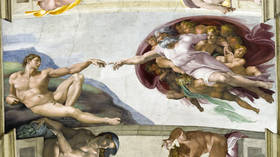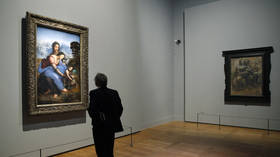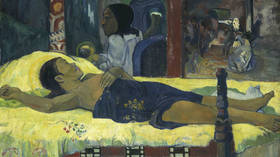Woke Yale stops teaching ‘problematic’ European art canon, proving we no longer deserve the classics
Alexander Adams
Alexander Adams is a British artist, poet and critic. He has published several books of fiction and poetry. His book ‘Culture War: Art, Identity Politics and Cultural Entryism’ (2019) is published by Societas. His art is in museum collections worldwide.
3 Feb, 2020 15:31

Yale University is abandoning one of its core courses, a comprehensive survey of 700+ years of Western art. It has been deemed too Western, white, and male – and now the art canon gets thrown under the woke bus.
Yale University has announced that it is scrapping the course “Introduction to Art History: Renaissance to the Present”. This course is an overview of the development of Western art, forming a handy survey of the visual culture of Europe and North America.
From this autumn, the course will be discontinued despite being popular and oversubscribed. Some students expressed disappointment, stating that the current course is a valuable primer in culture.
Course tutor Tim Barringer said: “I don’t mistake a history of European painting for the history of all art in all places.” He also called the teaching of Western art history in isolation as “problematic”. In effect, Yale believes a course about Western culture is too Western. Barringer’s statement echoes that of the director of undergraduate studies, Marisa Bass, who said: “There has never been just one story of the history of art.”
Rather than teach one that does not fit the multicultural outlook of American university teachers, Yale has decided to abandon the most effective method of comprehending and memorising Western art. Instead it will teach thematic courses.
Yale is turning its back on the means used for five centuries to frame visual culture, the canon.
What is the canon?
The canon is a teaching device, a list of great artwork explaining the development of artistic tradition, selected according to influence, innovation and appreciation. It is used to instruct people through a series of related highlights which are ordered to make a narrative. This has been true since Giorgio Vasari published the first modern history of art, The Lives of the Artists, in 1550. Vasari concluded that book by discussing his friend Michelangelo, portraying the whole history of Italian art as leading to Michelangelo’s genius.
The idea of art being developed incrementally and sequentially to reach an apex of perfection is a touch straightforward but it is not unreasonable to think that Cimabue led to Giotto and Masaccio then, eventually, Michelangelo. It may not be wholly accurate but it is comprehensible and easy to remember. In the same way we have mnemonics to learn the spectrum and sequence of planets, so the canon teaches us an art tradition.
For 500 years, until the 1960s, the system seemed like common sense.

‘Too white, too male’
When feminists in the 1960s began to complain that history was written by men about men for men, the fine-art canon came into immediate suspicion. Seeing only white Christian male artists, feminists claimed the art reflected a racist, sexist Christian West. Yet their beliefs came from a misunderstanding. Due to historical reasons, women artists had very rarely carved stone or created large oil paintings on religious and historical subjects; therefore there are no women in the pre-modern fine art canon.
Feminists worked backwards, looking at men in the canon and assuming they had been selected due to their sex. Canonical art is revered because of its quality not because of demographic characteristics of creators. Strictly speaking, the canon is only art, not artists.
The most important artist in the Western canon is Leonardo da Vinci – a gay, left-handed, vegetarian atheist – hardly the epitome of majority values.
ALSO ON RT.COMArtemisia Gentileschi: Rediscovered genius or token feminist in the culture wars?Changing culture from the inside
For feminists and other social revolutionaries there were three impulses. 1) rewrite the canon by championing neglected female artists, 2) build multiple alternate canons for women, non-white people, non-Europeans, gay people and so on, and 3) destroy the validity of canons. All three courses were pursued simultaneously by different public figures. Writer-teachers Linda Nochlin, Lucy Lippard, and Griselda Pollock built stellar careers working in academia and publishing. They were avowed activists, seeking to change society through disrupting cultural standards, using their positions of influence within the establishment.
Feminists prompted lesser-known artists such as Artemisia Gentileschi and Judith Leyster to be treated as equal to male counterparts; multiple exhibitions, books and university courses addressed the “suppressed stories” of minorities within the arts; Post-Modernists attacked the foundations of judgment and proclaimed that consensus was sublimated force imposing the will of the majority.
Ultimately, this multiple approach induced the crisis visible today. Addition of figures (expansion), inclusion of non-European strands (dilution) and undermining competency hierarchies (discrediting) has crippled Western academies as efficient transmitters of culture. The expanded canon is effectively the death of the canon because it is no longer coherent and comprehensible. This revised canon is unmanageably vast. Impossible to teach, memorise or explain, the expanded, diluted, discredited canon ceases functioning as a reliable guide and it is dropped.
Losing our culture
Teachers at many Western universities are paralysed by a crisis of conscious and terrified of being accused of racism and sexism by woke scolds. The canon is now so weakly defended, poorly understood and timidly taught that Yale finds it easier to abandon the canon than teach it. If a society stops believing its foundational story, it cannot be transmitted to the next generation and culture is lost.
Aren’t the glories of Western civilisation worth more than an embarrassed shrug? If we fail to cherish and explain the greatness of Giotto, Michelangelo, and Rembrandt then we surely no longer deserve them.
The statements, views and opinions expressed in this column are solely those of the author and do not necessarily represent those of RT.


0 Comments:
Post a Comment
Subscribe to Post Comments [Atom]
<< Home